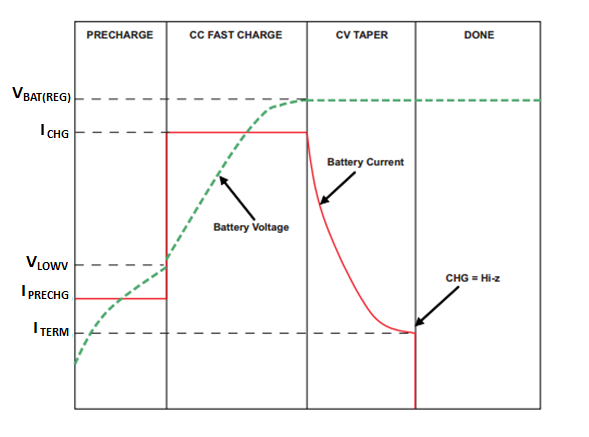SLUSD04C july 2018 – april 2023 BQ25150
PRODUCTION DATA
- 1 Features
- 2 Applications
- 3 Description
- 4 Revision History
- 5 Description (continued)
- 6 Device Key Default Settings
- 7 Pin Configuration and Functions
- 8 Specifications
-
9 Detailed Description
- 9.1 Overview
- 9.2 Functional Block Diagram
- 9.3
Feature Description
- 9.3.1 Linear Charger and Power Path
- 9.3.2 Protection Mechanisms
- 9.3.3 ADC
- 9.3.4 VDD LDO
- 9.3.5 Load Switch / LDO Output and Control
- 9.3.6 PMID Power Control
- 9.3.7 MR Wake and Reset Input
- 9.3.8 14-Second Watchdog for HW Reset
- 9.3.9 Faults Conditions and Interrupts ( INT)
- 9.3.10 Power Good ( PG) Pin
- 9.3.11 External NTC Monitoring (TS)
- 9.3.12 External NTC Monitoring (ADCIN)
- 9.3.13 I2C Interface
- 9.4 Device Functional Modes
- 9.5 Register Map
- 10Application and Implementation
- 11Power Supply Recommendations
- 12Layout
- 13Device and Documentation Support
- 14Mechanical, Packaging, and Orderable Information
9.3.1.1 Battery Charging Process
Figure 9-1 summarizes the charging process of the BQ25150 charger.
 Figure 9-1 BQ25150 Charger Flow Diagram
Figure 9-1 BQ25150 Charger Flow DiagramWhen a valid input source is connected (VIN > VUVLO and VBAT + VSLP < VIN < VOVP), the state of the CE pin determines whether a charge cycle is initiated. When the CE input is high and a valid input source is connected, the battery charge FET is turned off, preventing any kind of charging of the battery. A charge cycle is initiated when the CHARGE_DISABLE bit is written to 0 and CE pin in low. Table 9-1 shows the CE pin and bit priority to enable/disable charging.
Table 9-1 Charge Enable Function Through
CE Pin and
CE Bit
| /CE PIN | CHARGE _DISABLE BIT | CHARGING |
|---|---|---|
| 0 | 0 | Enabled |
| 0 | 1 | Disabled |
| 1 | 0 | Disabled |
| 1 | 1 | Disabled |
The following figure shows a typical charge cycle.
 Figure 9-2 BQ25150 Typical Charge Cycle
Figure 9-2 BQ25150 Typical Charge Cycle